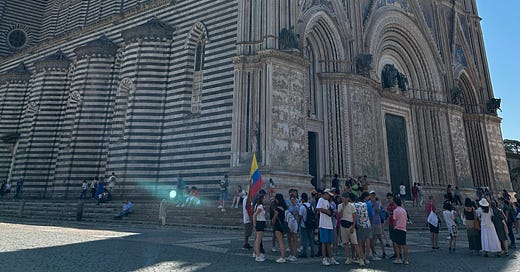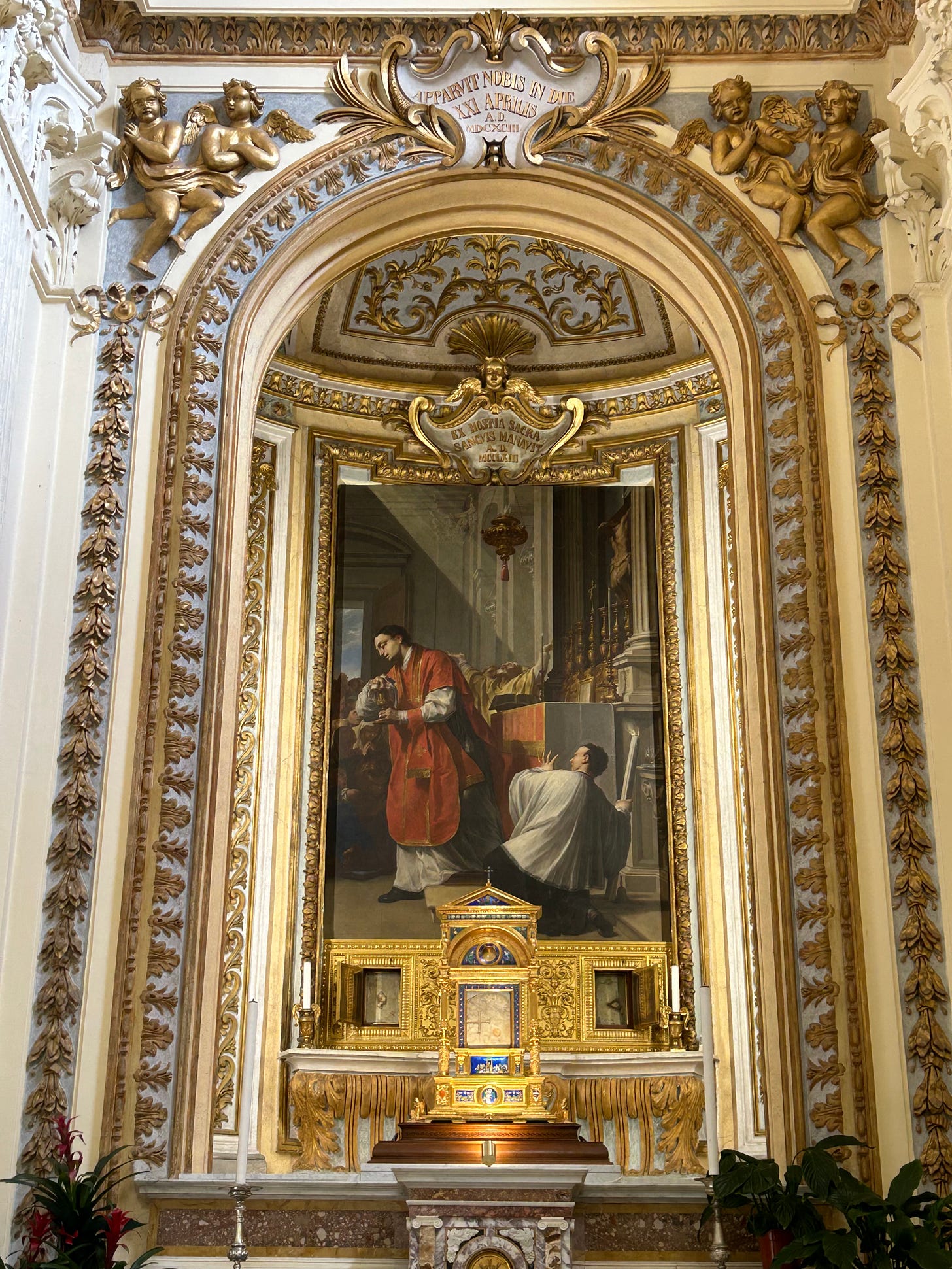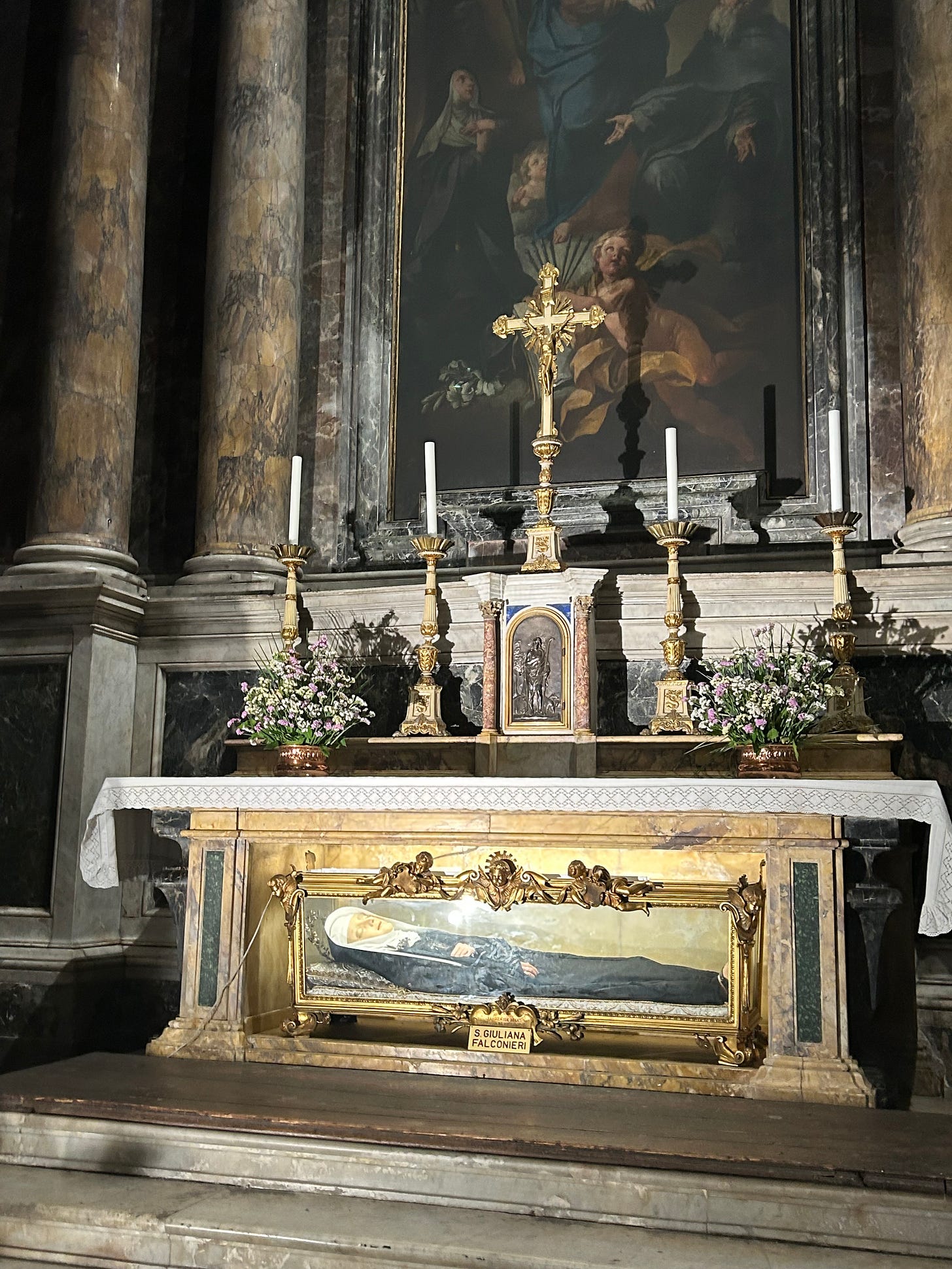Tomorrow is the feast of Corpus Christi (Latin for Body of Christ), on which we celebrate the incomparable gift of Christ Himself in the Holy Eucharist. Although we celebrate the institution of the Holy Eucharist on Holy Thursday when it happened, the Holy Father Pope Urban IV decided that we needed another special feast - just for the Blessed Sacrament. Saint Juliana of Liège (1192-1258 A.D.) especially petitioned and advocated for this feast, based on revelations she received from Our Lord.
Pope Urban IV then issued a papal bull called “Transiturus de Mundo” on August 11, 1264, extending this feast to the universal church. St. Thomas Aquinas, who was teaching at Orvieto from 1261 to 1265 (we got to see his desk when we were there!), also requested this feast, and the pope asked him to write special hymns to be sung on that day. He gave us the beautiful Lauda Sion, Pange Lingua, and Adoro Te Devote.
Another event that contributed to the pope’s decision was the Eucharistic Miracle of Orvieto in 1263. At the time, the pope was living in Orvieto. A German priest, saying Mass at what is now St. Christina’s Church in Bolsena, Italy, was having doubts about the True Presence of Jesus in the Eucharist. Suddenly, the Host began to bleed onto the corporal (linen cloth). The blood stains have remained and can be seen on special days on the corporal at the magnificent Duomo of Orvieto, Italy. (See my photo above; we were blessed to visit it in 2023.) The Duomo was built to house this precious relic.
The marble altar where the German priest had celebrated Mass also was stained with Blood…and that can be seen in Bolsena (which we also got to visit!). Below you can see a picture of the place where it happened, with the blood-stained pieces of the altar preserved.
Pilgrims can read about the scientific testing done on the blood-stained corporal. On one of the signs, written in Italian and English, it says:
“INFORMATION REVEALED UNDER UV FLUORESCENCE
The information obtained through ultraviolet fluorescence indicates the presence of blood separated into plasma and serum. Scientific studies indicate
that the death of Jesus was caused by infarct rather than a stab wound, and that the blood of a dead person separates into plasma and serum. The Gospel of John 19:34 confirms that blood (plasma) and water (serum) issued from the stab wound to the chest. The blood of the Eucharistic Miracle present on the
Holy Corporal reminds us of the death of Jesus for the remission of our sins.”
During this beautiful month of the Sacred Heart of Jesus, we can contemplate how Our Lord’s Precious Blood flowed from His Heart after it was pierced!
Another Amazing St. Juliana
The date of the Feast of Corpus Christi changes each year, because it is always on the Thursday after Trinity Sunday, which changes depending on the date of Easter. But this year, it falls on June 19th, which happens to be the feast of another Saint Juliana - St. Juliana Falconieri (1270-1341).
St. Alexis Falconieri was one of the Seven Holy Founders of the Servite Order. His brother Clarence and sister-in-law Ricordata had not been blessed with children. Clarence was a wealthy cloth merchant. “By this means he had become enormously wealthy,” writes Marie Conrayville, in her 1914 book St. Juliana Falconieri: A Saint of the Holy Eucharist. “And it is said that as he advanced in years he became assailed by scruples as to whether he might not have exceeded the bounds of strict justice in realizing his profits.”
Clarence reached out to his brother St. Alexis, and his brother recommended that Clarence ask Pope Urban IV. The pope pardoned him, telling him to donate the money that he thought he may have acquired unjustly to the building of the Church of the Annunziata in Florence.
“But there is a saying among the saints that God is never outdone in generosity, and so it pleased Him, in the designs of His beneficent goodness, to bestow a treasure on His faithful servant far exceeding the earthly riches which Falconieri had so generously lavished upon the decoration of His holy temple.” (p. 13, Marie Conrayville)
God blessed Clarence and Ricordata with a baby girl in 1270, just six years after the feast of Corpus Christi was extended to the universal Church. Her uncle, Saint Alexis Falconieri, was her godfather in baptism.
“She loved to hear about God and holy things, and would spend hours at her saintly uncle’s knee, listening to his stories of the saints and their heavenly country.” (p. 15, Conrayville)
At the age of 14 or 15, she vowed her virginity to God. Now her statue stands in St. Peter’s Basilica in Rome as one of the founders of Religious Orders. She was the first Servite nun.
This Saint Juliana also ardently loved Our Lord in the Blessed Sacrament. “For hours she would remain kneeling in the Church of the Annunziata, and sometimes, when ‘not a sound broke on the dream-like calm round Jesus’ Altar-Throne,’ her body, drawn from the earth by the intensity of her love, would be miraculously suspended in the air for a considerable length of time.” (p. 44, Conrayville)
She taught the children, started convents, trained the Sisters in the spiritual life, visited the sick, the poor, and the prisoners. She was also a peacemaker in battle-torn Florence.
“We read how the gentle Servite nun in her poor patched habit and bare feet used to go, on hearing of some conflict about to take place, and, crucifix in hand, beseech the combatants not to grieve the Sacred Heart of Christ by their wicked and unnatural conduct.” (p. 48)
At the end of her life, when she lay dying, she was unable physically to receive the Eucharist. So she begged the priest, Father Jacopo, to lay a corporal on her upper body, and lay the Host on it, that she might be close to Him as she died. After much begging, he relented.
The Host disappeared, and St. Juliana exclaimed, “O, my sweet Jesus!” as her soul slipped away to Heaven. The priest looked everywhere for the Host, but it was gone. As her body was prepared for burial, a mark, the size and shape of the Blessed Sacrament, was found over her heart.
“The last beat of her faithful heart had throbbed in unison with His.” (p. 57) Now her body rests in the Church of the Annunziata in Florence (see my photo above), where her father had humbly contributed his funds all those years ago.
Happy Feast of Corpus Christi, and
Happy Feast of St. Juliana Falconieri!






